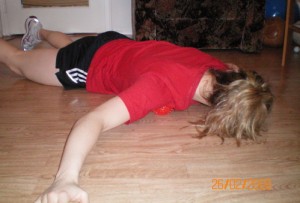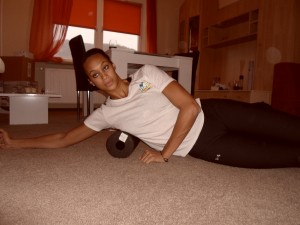Got rounded shoulders and starting to get a very unattractive hunchback? Never fear, there is a way to straighten up, and quite a few good reasons why. The nature of our lives, stresses, work and how we move all dictate our posture. Sitting at a desk all day can lead to rounded shoulders and very poor posture, and that posture has negative implications far beyond how you look. Poor posture and subsequent lack of thoracic mobility can cause you a host of problems that can be quickly fixed if addressed correctly.
Why You Need To Improve Upper Back Posture
Stop looking like a hunchback
This is an obvious one. Everyone wants to look good. Most of the reasons associated with changing your physique and getting in better shape are simply to look better. Don’t ruin all your hard work or make yourself not achieve your goal for something as simple as your posture. Your mum wasn’t wrong, standing up tall and keeping your shoulders back is an important part of correcting your posture and making sure you look great.
Improve shoulder health
Bad thoracic posture can wreak havoc with your shoulders. Basically your scapula sits on your rib cage, around the upper back area. If you have bad posture you are messing around with your scapula. Your scapula is absolutely imperative to shoulder health. Having poor scapula mobility, stability or function will almost certainly lead to shoulder problems.
Stop neck and back pain
Excessive kyphosis (which is the official name of the hunchback) can lead to neck and upper back pain. That nagging pain between your shoulder blades that we have all felt at some stage is often attributed to poor posture. If you have a rounded upper back posture, it is likely that the muscles of your neck are on stretch as well. When you have poor upper back posture your chin tends to go towards The constant strain can cause a lot of tension in the neck and subsequent headaches.
Breathe better
When you have poor upper back posture the severe kyphosis can result in the chest cavity getting smaller. What this means is breathing difficulties. You rib cage isn’t able to expand as well as it should and restricts the very important work of your diaphragm. You won’t be able to get as much oxygen in with each breath and your breathing will be somewhat inhibited.
These are just a few of the most common problems that poor posture can cause. The list is endless. You need to start seeking a solution, get some better thoracic mobility and start standing up straight today. Lucky you are here…read on.
How to improve upper back posture
Before I start with any tips and exercises you need to do, there is one important thing we need to get straight. Do everything you do, every day, all the time with good posture. Keep moving and understand that the best posture is the one that is always changing. When you sit at a desk, don’t hunch over the computer too long and make sure you get up and move around enough. When you exercise, exercise in good posture, or you will just get really good at having bad posture! No need to reinforce our bad habits. The exercises you can do to fix your upper back posture and improve your thoracic mobility will only work if you complement it and fix what you do 98% of the time. Now lets start with the solution…
Be aware of your hips
Yes this post is about upper back posture, you didn’t accidentally move pages. Your hips are important and often missed when talking about your upper back. If you have an anterior pelvic tilt, you are at risk of a more kyphotic posture. If your pelvis is tilted forward then you are in lordosis and you have a large curve in your lower back. If the curve in you lower back grows, naturally the curve at the top will as well to compensate. Sometimes people focus on doing a lot of upper body exercises, when the problem actually lies at the hips. So if you have an anterior pelvic tilt, check out this post to see what that is, then you need to address that as well as working the upper body problems.
So how do I fix my hips?
Again, make sure you check out this post so you can understand whats going on better. However, as a general rule the first thing you need to have a good look at your hip flexors and your glutes. Your hip flexors are often tight and overactive, and therefore your glutes are inhibited and not working correctly. Your hip flexors then pull your pelvis down, and your glutes don’t stop it! Not only are you then in lordosis and kyphosis, your hamstrings and lower back do the hip extension work that your glutes should be doing, and you are at more risk of soft tissue injuries to the area. If your abs are weak, they are also going to let your hip flexors do more work and tilt the pelvis forward. So basically, stretch your hip flexors and hamstrings, and make you you strengthen the abs and the glutes… if you are in an anterior tilt. If not, ignore what you read and move onto the next section!
Addressing the upper body
There are two things you can do to help your upper body posture. Soft tissue work and strength work. You need to address the right areas with soft tissue work, which are the areas that need to be loosened and are often tight and pull you into bad posture. Combine that with strength exercises to correct your posture and strengthen up the slack areas.
Soft tissue work
Pecs
Often your pecs can get tight and troublesome. Considering their attachment at the front of the shoulder they can act to pull the shoulders around. it doesn’t hurt to stretch and do some soft tissue work on them.

Lats
These guys do a lot of internal rotation, which involves bringing your shoulder forward somewhat. Make sure you roll them out with the foam roller frequently.

Thoracic Extensions
Grab two tennis balls, put them in a sock and get ready to loosen up that upper back. Slowly roll back over the balls and extend your upper back. Come back up like a little sit up, move the ball slightly up or down your back depending on where you started and repeat again. You can also do this over a foam roller, I just find the tennis balls get deeper.

If you are interested in how to release your whole body with a foam roller and tennis ball, with extra tips on all these muscle groups make sure you check out my Ultimate Self Massage Guide here.
Strength and corrective training
Now the fun part… what you need to add to your program. These aren’t a one size fits all cure, but in general for people with rounded shoulders and kyphotic posture these will help you out a lot.
Wall Slides
Stand with your back against the wall and out a foots length away from the wall. put your arms up behind your head and back of your hands flat against the wall. Drop your elbows down and keep them against the wall at all time. This encourages your shoulder blades to move on your rub cage correctly, and keeps you in a great posture throughout the exercise.
Face Pulls
We’ve discussed this exercise in detail a few times on Laurens Fitness, but basically this works your scapular retractors, which is what we need working a lot better if we want to have great posture. Keep the elbows high throughout the exercise and start light if you haven’t done them before, they are challenging. They will ensure you have good shoulder health as well as posture.
One Arm Rows
I like any kind of one arm row for posture correction, but in this case I prefer standing. This video says it all. The nice guy talking is Eric Cressy, a shoulder guru.
Extra External Rotation
These are corrective and tough all at once. They work your upper back and your external rotators and will correct a lot of weaknesses people with bad upper back posture will have. You can also hold some very light plates in your hands when you do this exercise once you get the hang of it. Do it slowly and stop quickly between the row and the external rotation.
Just add these exercises into your program. try to do at least 2 sets of 10-15 of each exercise as some preventative work early on in the program. Will also prime your body with good posture and warm it up for the main program.
Don’t forget you can do all the corrective exercise in the world, but if you are walking around like a hunchback all day, and bending over your computer for the rest of it, you may as well stop. Combine these exercises with diligence in your daily posture and you will quickly see a result. Ignore what you do outside of the gym and your hard work will go to waste.
Any questions or comments leave them below and I’ll get back to you as soon as possible!
Sharon says
Great article, Lauren! Very timely too. I was at a Kyphosis/Lordosis class yesterday taught by a Feldenkrais practictioner and IMO it was light on the actual doing something about the problem. Thanks for outlining these exercises.
Lauren says
Great to hear from your Sharon! Thanks for the good feedback.